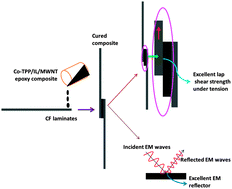Epoxy composites containing cobalt(ii)-porphine anchored multiwalled carbon nanotubes as thin electromagnetic interference shields, adhesives and coatings
Abstract
Herein a facile strategy has been adopted to design epoxy based adhesive/coating materials that can shield electromagnetic radiation. Multiwalled carbon nanotubes (MWNTs) were non-covalently modified with an ionic liquid and 5,10,15,20-tetrakis(4-methoxyphenyl)-21H,23H-porphine cobalt(II) (Co-TPP). The dispersion state of modified MWNTs in the composites was assessed using a scanning electron microscope. The electrical conductivity of the composites was improved with the addition of IL and Co-TPP. The shielding effectiveness was studied as a function of thickness and intriguingly, composites with as thin as 0.5 mm thickness were observed to reflect >97% of the incoming radiation. Carbon fibre reinforced polymer substrates were used to demonstrate the adhesive properties of the designed epoxy composites. Although, the shielding effectiveness of epoxy/MWNT composites with or without IL and Co-TPP is nearly the same for 0.5 mm thick samples, the lap shear test under tensile loading revealed an extraordinary adhesive bond strength for the epoxy/IL–MWNT/Co-TPP composites in contrast to neat epoxy. For instance, the lap shear strength of epoxy/IL–MWNT/Co-TPP composites was enhanced by 100% as compared to neat epoxy. Furthermore, the composites were thermally stable for practical utility in electronic applications as inferred from thermogravimetric analysis.



 Please wait while we load your content...
Please wait while we load your content...